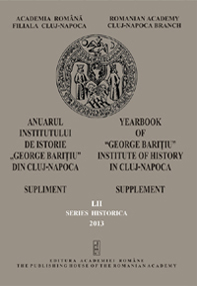Principatul Transilvaniei şi relaţiile habsburgo-otomane în a doua jumătate a secolului al XVII-lea. Schimbările survenite în statutul politic
Principality of Transylvania and Habsburg-Ottoman Relations in the Second Half of the Seventeenth Century. Changes in Political Status
Author(s): Călin FelezeuSubject(s): History
Published by: Editura Academiei Române
Keywords: Transylvania; autonomous status; buffer-zone; antihabsburgic;
Summary/Abstract: The Transylvanian principality was tormented all along the 17th century by the inner fights of the noblemen, the authoritarian rulings of Gabriel Bethlen and the two Gh. Rákoczy princes, but mostly by the mid-century intervention of the Ottoman Porte in the autonomy of the principality. The intervention was sanctified by the disastrous Polish campaign of Prince Gh. Rákoczy II which determined the Porte to modify the privileged status of the principality, aligning it from an international political point of view to the other two Romanian principalities. Through the tightening of the “safety belt” around Transylvania, the ottoman Empire foresaw the annihilation of the role Transylvania had within the Romanian coalition in the anti-Ottoman fight and was placing it in the buffer-zone to the west. The diminishing of the antihabsburgic role of the principality and the displacement of the political-military buffer-zones to the west has visibly decreased the geopolitical position of Transylvania and, as a sequence of the Transylvanian campaign of Teleki, it even found itself abandoned between the two European colossi.
Journal: Anuarul Institutului de Istorie »George Bariţiu« - Series HISTORICA - Supliment
- Issue Year: LII/2013
- Issue No: LII/Sup
- Page Range: 297-304
- Page Count: 8
- Language: Romanian

